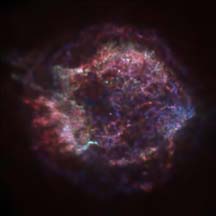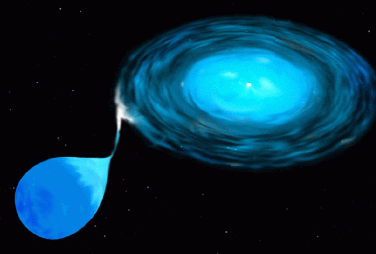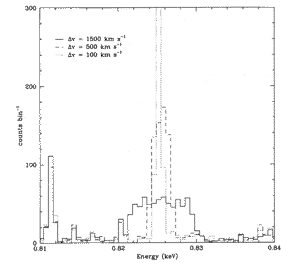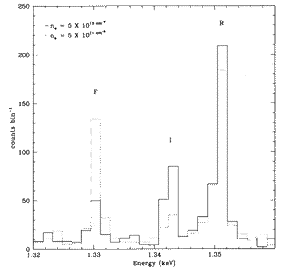
Here is a page at MIT with some
recent Chandra HETG data.
| A New Era of Astrophysical X-ray Spectroscopy has begun. Here is one of the very first Chandra spectra -- from a collisional plasma on the surface of Capella, which is a star not unlike the sun. |
 |
As this figure indicates, X-ray spectra provide information about what elements are present, but the
high resolution spectra that are becoming available now can provide much more information than this.
Here is the first-light HETG
spectrum of Capella, shown in more detail along with notes about some of the X-ray diagnostics of the hot
coronal plasma on this star.
|
| Of course the vast majority of Chandra press involves images rather than spectra. This is an image of the Cas A supernova remnant made with the ACIS detector on Chandra. There is some low resolution spectral information in this image (the chips in the ACIS detector have some inherent spectral discrimination), which is color coded according to wavelength. Each color/wavelength represents (roughly) a different chemical element. The surprising result of this observation is that the supernova turns itself inside-out when it explodes, with the oxygen-rich outer layers of the progenitor star ending up on the inside of the remnant while the iron-rich core gets mixed into the outer regions of the remnant. Read more about the results here. |  |
| Sources like Seyfert galaxies show absorption lines from an obscuring medium which is both "backlit" by the hard, central X-ray source and photoionized by it. Here's an unprecedented X-ray absorption spectrum of a Seyfert galaxy taken with the Chandra LETG Spectrometer. |
 |
Absorption spectra like this are an excellent means for diagnosing the ionization balance in the absorbing medium. Notice that consecutive ionization states of a given element appear near each other and in sequence in such a spectrum. This is due to the affinity of X-rays for inner-shell electrons. |
| When there is a transition involving an inner-shell electron, the presence of "spectator" electrons in outer shells acts only as a perturbation on the energy of the transition. Therefore inner-shell transitions behave spectrally as if they involve helium-like transitions with a modest shift toward lower energies (longer wavelengths) proportional to the ionization stage producing the line. |
 Benchmarking codes used to model such photoionized X-ray sources is of crucial importance. X-ray spectra of X-ray photoionized, low density laboratory plasmas are beginning to be studied for the purpose of understanding the high-resolution spectra that are being produced by the new generation of X-ray telescopes. |
Photoionized sources around compact objects can also show emission lines. In these
sources the levels giving rise to the
to the lines are populated by recombination following photoionization. This new Chandra spectrum of the X-ray binary
Cygnus X-3 shows very narrow recombination continua, indicative of plasma much colder than its ionization
state would otherwise indicate.
 |
| All these data are indicative of the new era of high-resolution astrophysical spectroscopy. Many diagnostics based on line intensities and even profiles will be available to X-ray astronomers for the first time. They will provide information about temperatures, ionization levels, densities, column densities, bulk velocities, chemical composition, and radiation field properties. |

|

|
|
The helium-like oxygen, neon, magnesium, silicon, and sulfur features have the potential to
discriminate among several models of hot star X-ray production that each predict X-ray emitting
gas of a different range of densities. And the Doppler broadening has the potential to tell us whether the
X-ray emitting hot plasma in early-type stars is distributed throughout the stellar wind or confined (presumably
by magnetic fields) to low velocity regions near the surface of the star.
In my XMM proposal to observe the B star e CMa I enumerate several additional specific spectral diagnostics that we can bring to bear on the problem of hot star wind X-ray emission (see the table on page 2). Also, you might want to check out a recent conference paper by Fritz Paerels on X-ray spectral diagnostics and the new X-ray spectroscopy missions. |
|
XMM has been launched. See pictures of the
launch and find out information about this telescope's capabilities.
|
 |
| Return to David's Home Page |